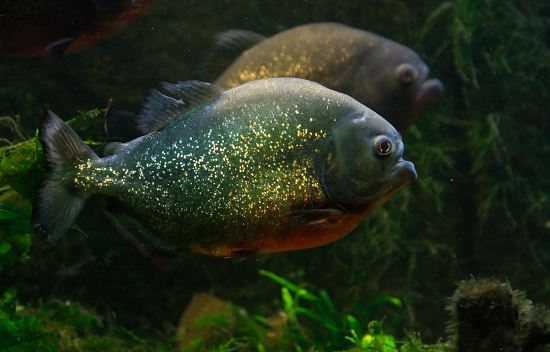Study: Piranhas Bark With Their Bladders
Red-bellied piranhas are already scary enough, but it turns out that these hyper-aggressive carnivorous fish are also quite the talkers. Using hydrophones to record the fish in captivity, Eric Parmentier from Belgium’s Université de Liège recorded a series of sounds that suggest the fish have a lexicon of audio signals produced in a rather unique way. The study has recently been published in The Journal of Experimental Biology.
The researchers were able to identify three distinct sounds, or “barks,” produced by the fish. In their research, they found that these barks were repeated in similar situations, suggesting that the sounds carry some kind of meaning. For instance, a low grunting sound seemed to signal other piranhas to keep their distance from the barking fish. A rhythmic thud bark, the researchers found, was associated with circling and fighting other fish. Lastly, chasing and nipping fish seemed to be the final level of signaling with a soft creating sound produced by their gnashing their teeth.
Once the sounds were discovered, the researchers were then tasked with discovering their origin. The creaking sound was easy to pin down, since it was clearly a product of the fish’s famous teeth. The other two were a bit more difficult to pin down. Previous piranha projects had revealed that the fish’s swim bladder — the organ that allows fish to adjust their boyancy in the water — was used to produce sound.
Using the swim bladder as a starting point, Parmentier’s team found that stimulating the muscles around the organ produced sound. Once the stimulation ceased, so did the sound. This is significant since it showed that the muscles were creating the sound and the bladder was not resonating, in which case the sound would have continued after the muscles ceased moving. It also showed that the frequency and pitch of the barks were determined entirely on the muscle contractions.
Though three audible signals does seem to limit the possibility for great piranha oration, Parmentier thinks that there could be others. Specifically, he believes, associated with mating. However, his team is limited by what behaviors can be observed in the lab. Their work is also limited by the fact that they’re working with prianhas, which nearly cost Paramentier his finger and sent he and other member of the team to the hospital. Scary stuff.
(JEB via Wired, National Geographic, image via Wikimedia)
- Your fish hate you
- This shark glows in the dark
- This shark flies through the air and is not a shark
- This woman killed two sharks so she could set a world record
Have a tip we should know? tips@themarysue.com
